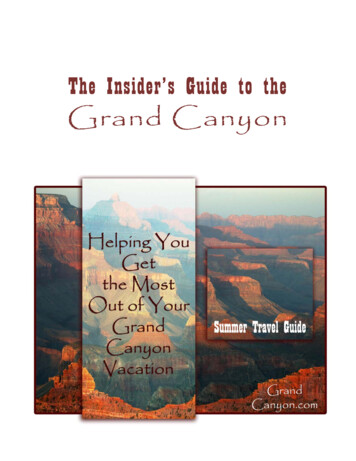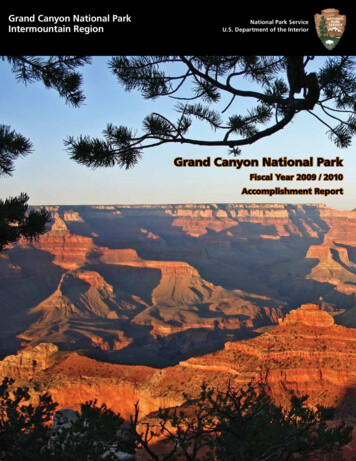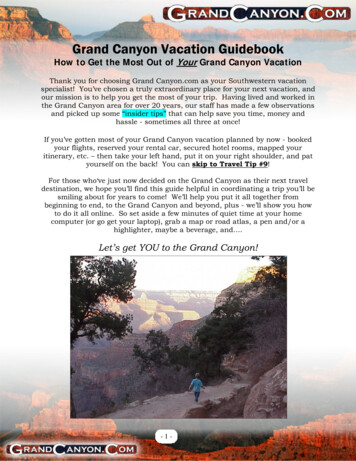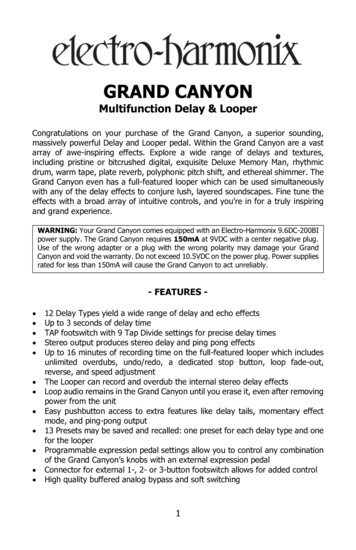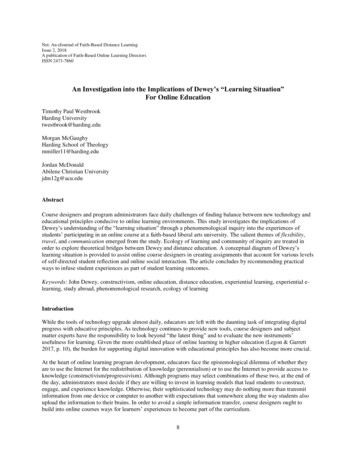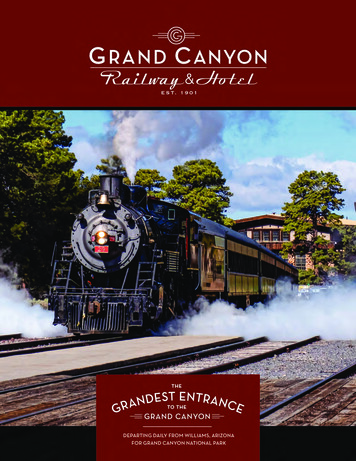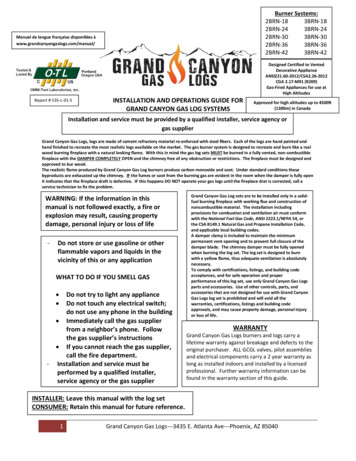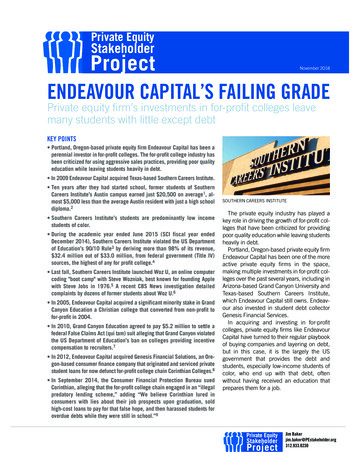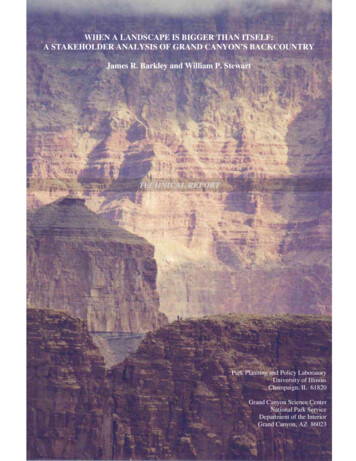
Transcription
The Grand Canyon of the Colorado Riveredited byDavid L. AllesWestern Washington Universitye-mail: alles@biol.wwu.eduLast updated 2012-6-29Note: In PDF format most of the images in this web papercan be enlarged for greater detail.1
The Grand Canyon, one of the deepest canyons in the world with a depth of 1 mile(1.6 km), can be seen in this spectacular photograph taken from the space shuttle. Thecanyon is 280 miles (450 km) long and averages nearly 10 miles (16 km) in width. Theview is to the southwest with the snow-covered Kaibab Plateau in lower right portion ofthe image and the Coconino Plateau in the upper left. The lower portion of MarbleCanyon (bottom center) ends where the Little Colorado River (lower left) joins theColorado River. This marks the point where the Grand Canyon turns west and beginscutting through the Kaibab Plateau.(Space Shuttle photograph courtesy of NASA)2
This satellite image shows the Colorado River from Lake Powell on the border ofUtah and Arizona (upper right) through the Grand Canyon to Lake Mead (center left) onthe border between Arizona and Nevada.(MODIS image courtesy of NASA)For area maps of the Grand Canyon go to:http://www.nps.gov/grca/planyourvisit/maps.htm3
Relief Map of Arizona with the Grand Canyon in the Northwest Corner(Map courtesy of USGS)4
The Colorado River begins its 280 mile meandering journey through the GrandCanyon at Lee’s Ferry (above), the zero point for measuring mileage downstream.5
Downstream from Lee’s Ferry the river has cut the narrow, steep-walled MarbleCanyon. As shown above, its rock walls start rising sharply about 30 miles downstream.Further downstream at the confluence of the Little Colorado, Marble Canyon gives wayto the deeper, broader Grand Canyon as the river turns sharply west. Although MarbleCanyon bears little resemblance to the expansive canyon downstream of it, it cuts throughthe same rocks and is considered part of the same geological formation.(Photograph by Bob Ribokas)6
This picture of Marble Canyon looks upstream to the north. In the bottom left theLittle Colorado River can be seen entering the Colorado at mile 62. The waters of theLittle Colorado are usually turquoise but runoff from thunderstorms has turned them areddish brown.7
During the thunderstorm season the Little Colorado receives much of its flow fromupstream mesas and mountains that easily erode. By the time the Little Colorado arrivesat the Grand Canyon, it has the consistency and color of a thick chocolate milkshake.When you see pictures of a muddy Colorado River in the Grand Canyon, it is often afterheavy summer thunderstorms when the Little Colorado is contributing a heavy load ofmud and silt. When the Little Colorado is not receiving water from the upper watershed(as pictured above) the entire flow comes from the Sipapu, a travertine spring. The HopiIndians believe this is where man emerged from the earth after passing through asuccession of worlds. The water is crystal clear, extremely alkali, and warm (around 78 F/14 C). The Little Colorado's bright turquoise color is the result of bleaching of bottomsediments by the river's heavy mineral load.(Photograph by J.& D. Gould http://www.gouldhome.com/grand/index.html )Web olr.htm8
One of the most spectacular examples of erosion anywhere in the world, the GrandCanyon is unmatched in the vistas it offers. Sunset at the Grand Canyon provided thisspectacular view from the Bright Angel trailhead looking northward from the south rim.Bright Angel trail intersects the river near mile 88.The thick sequence of sedimentary rocks exposed in the walls of the canyonprovide a remarkable record of the Paleozoic Era (550-250 million years before thepresent), but the canyon itself has been carved by erosion relatively recently, only duringthe past five to six million years.Web Referencehttp://www.durangobill.com/Paleorivers preface.html9
The View from Bright Angel Lodge on the South Rim(Photograph by Philip Greenspun http://photo.net/philg/ )10
Geologic Strata of the Grand CanyonFor more information on the geology of the Grand Canyon go to:http://www.kaibab.org/geology/gc geol.htmandhttp://www.classzone.com/books/earth age01.cfm11
The striking contrast between the light buff colored Coconino Sandstone and themuddy red Hermit Shale is cause for this portrait of a rock wall along the Bright Angeltrail in the Grand Canyon. The easily eroded shale was deposited as mud in flood plainsand tidal flats, and owes its red color to iron oxides. Fossilized reptile tracks and plantsare found in the shale. The mud flats dried and cracked as they were overrun byadvancing sand dunes. The tilted bedding and uniform size and purity of the quartz grainsof the Coconino formation indicates deposition as wind-blown sand. Some of that sandcan be seen filling a deep crack in the underlying red shale (right center).12
Layers of sedimentary rocks in the Grand Canyon (shown above) are nearly a mile(1.6 km) deep along the deepest portion of the canyon.(Photograph courtesy of National Academy of Sciences)13
Shown rising from the water’s edge, Vishnu Schist forms the Precambrianbedrock on which the Paleozoic sediments of the canyon lie.(Photograph by Philip Greenspun)14
Vishnu Schist and the younger Zoroaster Granite that intrudes it, as shown in thisimage, are some of the oldest rocks known, with respective ages of 2,000 million and1,700 million years old.(Photograph by Mark Meyer http://www.photo-mark.com/ )15
The ancient Vishnu Schist forms the inner gorge of the canyon from mile 77, asyou enter Upper Granite Gorge (shown above), to mile 130 at Granite Narrows.(Photograph by Bob Ribokas)16
William Bell of the Wheeler survey of 1872, took this photograph of the ColoradoRiver looking downstream from the mouth of Kanab Creek (mile 143). Downstream fromthis point for almost 25 miles the river is confined to a narrow inner gorge with nearvertical sidewalls of Redwall and Muav Limestone. Notice how the debris fan (lowerforeground) from Kanab Creek (right edge center) has a scoured appearance and littlevegetation.(Photograph courtesy of George Eastman House Still Photograph Archivehttp://www.geh.org/ne/mismi2/williambell sum00001.html#79:0014:0017 )17
This picture was taken just above Kanab Rapids in 1997. The rapids are formed bydebris washed out by Kanab Creek. High water has almost covered the debris fan whereBell took his picture of the river in 1872. Just the upper portion of the fan can be seenlower right of center.(Photograph by Bob Ribokas)18
At the Toroweap overlook (mile 176) on the north rim of canyon in the Tuweeparea you can stand on the edge of a red sandstone cliff and look straight down 3,000 feetto the Colorado River below. Toroweap Point’s first recorded non-Indian visitor wasJohn Wesley Powell in 1870, on his futile search for the three lost members of his 1869Colorado River expedition.William Bell took the first pictures of the Grand Canyon from the Toroweapoverlook. Above is Bell’s picture looking upstream from the point, showing the GrandCanyon below Cove Canyon as it was in 1872. The high point in the distance is calledBig Point.(Photograph courtesy of George Eastman House Still Photograph Archive)19
Again looking upstream from Toroweap Point, this picture shows theGrand Canyon below Cove Canyon as it is today.(Photograph courtesy of John Crossley)Web Reference http://www.durangobill.com/GCTour172.html20
Before 1963, melting snow in the upper Colorado River basin produced high flowsthat raced through the Grand Canyon each spring. An average peak discharge of 93,400cubic feet per second scoured large volumes of sediment from the river bottom. Later inthe summer, receding floodwaters deposited this scoured sediment and also sedimentcarried in from tributaries. This annual scour and fill process maintained large sand barsalong the river banks, kept sand bars clear of vegetation, and kept debris fans—depositsof cobbles and boulders that form at the mouths of tributaries—from constricting theriver. Reduced frequency of flooding since the completion of the Glen Canyon Dam hasreduced the size of sand bars and allowed vegetation to encroach on the channel, debrisfans to build up, and backwater areas used by native fish to fill in. In the 1872 Bellpicture from Toroweap Point, note the extensive sand bars stretching along the river. Inthe recent Crossley picture above, the sand bars along the same stretch of river aredrastically reduced."In 1996, after years of debate, scientists at the US Geological Survey agreed on aplan to restore the ecosystem. They hoped that releasing a massive flood through the damwould shift sediment trapped at the bottom of the river and rebuild the beaches. Later thatyear, they pumped an extra 1,290 cubic metres ofwater per second down the canyon for a week, at an estimated cost to power companiesof 2.5 million. It was a failure—there just was not enough sediment in the river toredistribute.In 2004 they tried again, timing the flood to coincide with an annual release ofsediment from the Paria River, just downstream of the Glen Canyon Dam. But despitehigh hopes, this failed too. The results directly contradict rosy predictions made in 1996,says the scientists’ report, which concludes that the only way to rebuild the sandbarspermanently is with a continuous source of new sediment.'Full restoration of the river is impossible,' says John Schmidt, a geomorphologistat Utah State University in Logan, who helped to plan the 1996 and 2004 floods. 'It is amuch more difficult challenge than anticipated.' He says it’s time for Americans torealize that they cannot have a huge power-generating dam and a natural riverecosystem."Dalton, R. (2005). Floods fail to save canyon beaches. Nature, 438(Nov 3), 10.21
Shown above is the bottom of the canyon as it is today below Toroweap Point justabove Lava Falls at mile 179. Again, note the lack of sand bars and the vegetation thathas built up along the river’s edge.(Photograph courtesy of John Crossley)22
The canyon begins to open up at mile 191 along the last stretch of the river beforeLake Mead. If you compare this portion of the Grand Canyon with almost any othercanyon, it is still very impressive. But if you compare it with portions of the GrandCanyon upstream, it is dull by comparison. The generic limestone cliffs bordering theriver still rise 2,500 feet from the river’s edge, but they are not as sheer as those in theupper canyon.(Photograph by Bob Ribokas)23
Sunset over Lake Mead near Pearce FerryPearce Ferry marks the traditional boundary between Lake Mead and the GrandCanyon. Here the low sandy banks around the lake give way to the cliffs that enclose theColorado River for almost 280 miles upstream.(Photograph courtesy of John Crossley)24
For further reading about the Grand Canyon see:Ives, Joseph C. (1861). Report upon the Colorado River of the West explored in 1857 and1858. U.S. Government Printing Office: Washington D.C.Stegner, Wallace E. (1954). Beyond the Hundredth Meridian: John Wesley Powell andthe Second Opening of the West. Houghton and Mifflin: Boston.Watkins, T. H., et al. (1969). The Grand Colorado. Palo Alto: American West.For more about the Grand Canyon on the web go to:Grand Canyon Explorer by Bob Ribokas http://www.kaibab.org/home.htmAmerican Southwest by John rand canyon/national park.htmlFor a virtual tour of the Grand Canyon by Bill tml----------------------To return to the Colorado River Index go ver.htmlFor the next paper in this series on the Colorado River go ado.pdfFor further information on related topics go to:Global Ecology and Remote Ecologyindex.htmlAlles Biology Home l25
at the Grand Canyon, it has the consistency and color of a thick chocolate milkshake. When you see pictures of a muddy Colorado River in the Grand Canyon, it is often after heavy summer thunderstorms when the Little Colorado is contributing a heavy load of mud and silt. When the Little Colorado is not receiving water from the upper watershed


